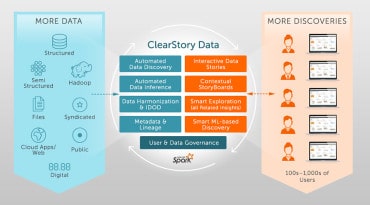
Digital Intelligence empowers enterprises to make a tremendous impact where it matters most: customer experience, competitive advantage, visibility, and compliance.
Successful automation initiatives can transform every facet of an organization, from the boardroom to the shop floor. In order to effectively deploy a Robotic Process Automation (RPA) project and realize the potential that automation can yield, businesses need to have an in-depth understanding of their organization’s processes. The most common and expensive mistake businesses make when implementing automation initiatives is failing to properly understand how their processes are actually performing and then choosing the wrong processes to automate. Leveraging actual business process data is critical to the long-term financial and technical success of any automation project. Rarely does the enthusiasm to just jump in and figure it out on the fly ever prove to be a recipe for success.
See also: Inside McDonald’s Digital Transformation
The data is available, but can you access it?
The challenge for many organizations is understanding how their processes operate in real-time, across diverse functional teams, and within siloed back-end systems. Traditionally, enterprises have tried to generate process insights by utilizing a combination of manual efforts and first-generation platforms, including process mining and business intelligence, which prove to be time-consuming, costly, and error-prone. Comprehensive process data that reflects end-to-end workflows is key to automation success. And it already exists in just about every enterprise software application.
Whether utilizing an ERP, CRM, or another application, the data is waiting to be put to use. Solutions such as Process Intelligence enable organizations to discover, assess, visualize, analyze, and monitor process flows. Powered by artificial intelligence and machine learning technologies, Process Intelligence delivers accurate, in-depth, and real-time process discovery, analysis, and monitoring, which help automation leaders to accelerate digital transformation initiatives.
Stop processes from failing
Many RPA projects initially fail. While a number of factors play a role in the ultimate results that an automation project delivers, understanding and automating the right processes is a key component of successful digital transformation. Automating the wrong processes can lead to wasted resources and less return on RPA investments. However, choosing the right processes for automation can be challenging without having a clear idea of how processes actually run. Many organizations think they understand how their processes work when, in reality, there are often tens or even hundreds of variations for a single process.
Traditional methods of discovering and analyzing processes involve internal personnel or outside consultants observing, timing, and documenting processes by hand, and then manually sorting and compiling the data. This time-consuming method usually takes several months to complete and is also highly subjective. The data reflects how the process performed during the specific instance in which it was being observed.
Other methods include business intelligence, which is a great asset in providing summary data and point-in-time metrics but lacks an understanding of the key to a process: time. Traditional process mining tools, many of which originated from the graduate program at Eidenhoven University, have made the assumption that corporate processes fit onto a simple process map, but neglect to recognize that processes function much more like a timeline.
Is a more accurate view of processes available?
One key differentiator between process mining and process intelligence solutions is the ability to reconstitute process histories for any kind of process, including ad hoc and case management processes that use only primitive events. These types of events include transaction log entries, audit table data, or any other records of an activity being performed and then deliver the data as a timeline, thereby providing a more accurate representation of how processes actually function. Process Intelligence can combine events sourced from different systems allowing the analysis of processes end-to-end even when multiple steps are performed across different systems of record. The result is a reconstruction of a dynamic model of historical process instances that serves as the foundation for a broad range of analyses. Understanding and analyzing processes end-to-end in their as-is state supports the successful automation initiatives.
While traditional process mining tools have been valuable in so far as they have been a catalyst to get people thinking about how to better understand their processes, one fundamental shortcoming of traditional methods is the concept that there’s a discoverable flowchart behind process logs. While this could be true in some extremely well-organized and clearly defined processes that are consistently executed as planned, for the majority of today’s businesses, there’s not a simple flowchart describing the process A-Z. Instead, there are multiple decision points producing an almost infinite number of possible combinations.
Process monitoring should reflect real life
Keeping in mind the complexity and diversity of most business workflows, what would a process flowchart look like if it were to reflect the process of treating a patient in an emergency room? If you factor in all possible forks and loops in the workflow, representing doctors’ decisions, test results, and changes in the patient’s conditions, the process representation will look less like a flowchart and more like an incomprehensible web. We generally refer to this as the plate of spaghetti effect, as the process map looks much like a plate of spaghetti. Even in simpler cases, customer support or sales management, for example, the number of steps, repetitions, and variations, could vary greatly.
Even when a process flowchart is simple, it still omits critical information by its very design – events that don’t fit into a simplistic model. To produce a readable diagram, traditional process mining tools filter out the events which don’t align with the steps of the flowchart. For example, in the emergency room scenario, the following steps could be placed in a flowchart: Patient arrived, Patient roomed, Provider assigned, and Patient released. However, where in this diagram would “Lab test ordered” fit? This critical step in the process could happen at any time from a patient arriving and a patient being released. Other solutions will filter out this “noise” because it is not easily mapped or does not consistently fit into the process flow in every single instance. Thus, you lose the important insight about how this process actually operates when you present the workflow in a flowchart model.
When the complexity, variations, and dimensions of a process is reduced or omitted to fit a simplified flowchart, critical data is lost. In our emergency room scenario, the frequency and timing of potential lab tests could yield important information and explain why the patient spent so much time in the emergency room or why several different providers were assigned to the patient during their visit. It is also important to understand the lab test workflows and utilize that data in the analysis.
Process Intelligence focuses on the time and relationship between steps in business processes and generates both an in-depth analysis of process histories and real-time monitoring and prediction of future process states.
Process Intelligence impacts RPA success
Data reflecting all dimensions of a process – timing, frequency, process variations and deviances, and sub-processes – is critical for successful digital transformation initiatives. Having this in-depth understanding of processes can help automation leaders identify the best use cases for RPA initiatives since complex processes can complicate automation initiatives.
Furthermore, because Process Intelligence provides a multidimensional view into how processes operate in their as-is state, automation leaders can accurately identify where bottlenecks are occurring and fix broken or ineffective processes prior to an RPA deployment. Fixing process bottlenecks prior to RPA implementation plays a crucial role in successful automation projects.
After deployment, properly monitoring and measuring outcomes of an RPA project are also key for successfully maintaining and optimizing automation initiatives. However, understanding how an automated workflow is performing can be challenging. Process Intelligence monitors all business-critical workflows and allows automation leaders to see how their RPA deployments are operating and fix any potential setbacks.
Process Intelligence also provides valuable data to demonstrate the impact of effective automation initiatives – both from a cost-savings and time-savings perspective. It can then be used to justify and validate plans for continued automation investments.
Process knowledge is important for successful digital transformation initiatives; however, having an understanding of all the critical information locked within semi-structured and unstructured content is also critical. It is dependent on having real-time access to all your business-critical data no matter which business process platform it lies within. This includes the vast amount of data that exists in various business documents, including claims, invoices, proof of delivery, loan agreements, contracts, orders, identity documents, tax forms, pay stubs, utility bills, and more. This understanding of both content and processes is referred to as having digital intelligence.
With Digital Intelligence, organizations gain the valuable, yet often hard to attain, insight into their operations that enables true business transformation. With access to real-time data about exactly how processes are currently working and the content that fuels them, Digital Intelligence empowers enterprises to make a tremendous impact where it matters most: customer experience, competitive advantage, visibility, and compliance.
The latest Everest Group Process Mining Products PEAK Matrix® Assessment 2020 illustrates that traditional process mining has deep roots among data professionals and automation leaders, but the Process Intelligence approach is gaining momentum – especially with the impact of stay at home orders, social distancing, and economic uncertainty. Business leaders need to have a valuable understanding of their business workflows, identify the best use cases for RPA projects quickly, fix process bottlenecks as soon as they occur, and continually optimize automation performance. Process Intelligence answers this call throughout the entire business, even across diverse workflows, departments, technology systems, and locations.



























